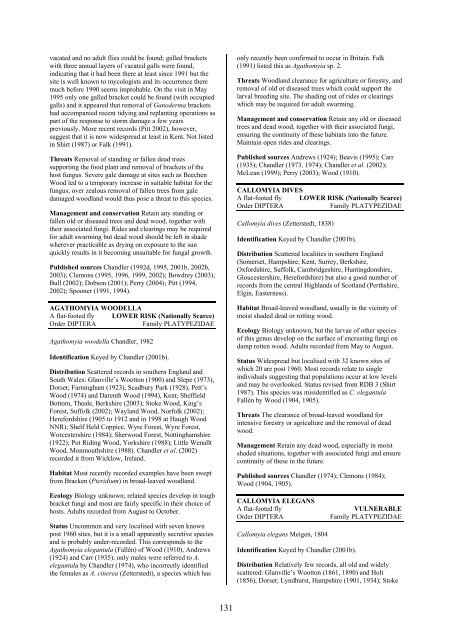Part 2: Nematocera and Aschiza not dealt with by Falk (1991) - JNCC
Part 2: Nematocera and Aschiza not dealt with by Falk (1991) - JNCC
Part 2: Nematocera and Aschiza not dealt with by Falk (1991) - JNCC
You also want an ePaper? Increase the reach of your titles
YUMPU automatically turns print PDFs into web optimized ePapers that Google loves.
vacated <strong>and</strong> no adult flies could be found; galled brackets<br />
<strong>with</strong> three annual layers of vacated galls were found,<br />
indicating that it had been there at least since <strong>1991</strong> but the<br />
site is well known to mycologists <strong>and</strong> its occurrence there<br />
much before 1990 seems improbable. On the visit in May<br />
1995 only one galled bracket could be found (<strong>with</strong> occupied<br />
galls) <strong>and</strong> it appeared that removal of Ganoderma brackets<br />
had accompanied recent tidying <strong>and</strong> replanting operations as<br />
part of the response to storm damage a few years<br />
previously. More recent records (Pitt 2002), however,<br />
suggest that it is now widespread at least in Kent. Not listed<br />
in Shirt (1987) or <strong>Falk</strong> (<strong>1991</strong>).<br />
Threats Removal of st<strong>and</strong>ing or fallen dead trees<br />
supporting the food plant <strong>and</strong> removal of brackets of the<br />
host fungus. Severe gale damage at sites such as Beechen<br />
Wood led to a temporary increase in suitable habitat for the<br />
fungus; over zealous removal of fallen trees from gale<br />
damaged woodl<strong>and</strong> would thus pose a threat to this species.<br />
Management <strong>and</strong> conservation Retain any st<strong>and</strong>ing or<br />
fallen old or diseased trees <strong>and</strong> dead wood, together <strong>with</strong><br />
their associated fungi. Rides <strong>and</strong> clearings may be required<br />
for adult swarming but dead wood should be left in shade<br />
wherever practicable as drying on exposure to the sun<br />
quickly results in it becoming unsuitable for fungal growth.<br />
Published sources Ch<strong>and</strong>ler (1992d, 1995, 2001b, 2002b,<br />
2003); Clemons (1995, 1996, 1999, 2002); Bowdrey (2003);<br />
Bull (2002); Dobson (2001); Perry (2004); Pitt (1994,<br />
2002); Spooner (<strong>1991</strong>, 1994).<br />
AGATHOMYIA WOODELLA<br />
A flat-footed fly LOWER RISK (Nationally Scarce)<br />
Order DIPTERA<br />
Family PLATYPEZIDAE<br />
Agathomyia woodella Ch<strong>and</strong>ler, 1982<br />
Identification Keyed <strong>by</strong> Ch<strong>and</strong>ler (2001b).<br />
Distribution Scattered records in southern Engl<strong>and</strong> <strong>and</strong><br />
South Wales: Glanville’s Wootton (1900) <strong>and</strong> Slepe (1973),<br />
Dorset; Farningham (1923), Scadbury Park (1928), Pett’s<br />
Wood (1974) <strong>and</strong> Darenth Wood (1994), Kent; Sheffield<br />
Bottom, Theale, Berkshire (2003); Stoke Wood, King’s<br />
Forest, Suffolk (2002); Wayl<strong>and</strong> Wood, Norfolk (2002);<br />
Herefordshire (1905 to 1912 <strong>and</strong> in 1998 at Haugh Wood<br />
NNR); Shelf Held Coppice, Wyre Forest, Wyre Forest,<br />
Worcestershire (1984); Sherwood Forest, Nottinghamshire<br />
(1922); Pot Riding Wood, Yorkshire (1988); Little Wenallt<br />
Wood, Monmouthshire (1988). Ch<strong>and</strong>ler et al. (2002)<br />
recorded it from Wicklow, Irel<strong>and</strong>.<br />
Habitat Most recently recorded examples have been swept<br />
from Bracken (Pteridium) in broad-leaved woodl<strong>and</strong>.<br />
Ecology Biology unknown; related species develop in tough<br />
bracket fungi <strong>and</strong> most are fairly specific in their choice of<br />
hosts. Adults recorded from August to October.<br />
Status Uncommon <strong>and</strong> very localised <strong>with</strong> seven known<br />
post 1960 sites, but it is a small apparently secretive species<br />
<strong>and</strong> is probably under-recorded. This corresponds to the<br />
Agathomyia elegantula (Fallén) of Wood (1910), Andrews<br />
(1924) <strong>and</strong> Carr (1935); only males were referred to A.<br />
elegantula <strong>by</strong> Ch<strong>and</strong>ler (1974), who incorrectly identified<br />
the females as A. cinerea (Zetterstedt), a species which has<br />
only recently been confirmed to occur in Britain. <strong>Falk</strong><br />
(<strong>1991</strong>) listed this as Agathomyia sp. 2.<br />
Threats Woodl<strong>and</strong> clearance for agriculture or forestry, <strong>and</strong><br />
removal of old or diseased trees which could support the<br />
larval breeding site. The shading out of rides or clearings<br />
which may be required for adult swarming.<br />
Management <strong>and</strong> conservation Retain any old or diseased<br />
trees <strong>and</strong> dead wood, together <strong>with</strong> their associated fungi,<br />
ensuring the continuity of these habitats into the future.<br />
Maintain open rides <strong>and</strong> clearings.<br />
Published sources Andrews (1924); Beavis (1995); Carr<br />
(1935); Ch<strong>and</strong>ler (1973, 1974); Ch<strong>and</strong>ler et al. (2002);<br />
McLean (1999); Perry (2003); Wood (1910).<br />
CALLOMYIA DIVES<br />
A flat-footed fly LOWER RISK (Nationally Scarce)<br />
Order DIPTERA<br />
Family PLATYPEZIDAE<br />
Callomyia dives (Zetterstedt, 1838)<br />
Identification Keyed <strong>by</strong> Ch<strong>and</strong>ler (2001b).<br />
Distribution Scattered localities in southern Engl<strong>and</strong><br />
(Somerset, Hampshire, Kent, Surrey, Berkshire,<br />
Oxfordshire, Suffolk, Cambridgeshire, Huntingdonshire,<br />
Gloucestershire, Herefordshire) but also a good number of<br />
records from the central Highl<strong>and</strong>s of Scotl<strong>and</strong> (Perthshire,<br />
Elgin, Easterness).<br />
Habitat Broad-leaved woodl<strong>and</strong>, usually in the vicinity of<br />
moist shaded dead or rotting wood.<br />
Ecology Biology unknown, but the larvae of other species<br />
of this genus develop on the surface of encrusting fungi on<br />
damp rotten wood. Adults recorded from May to August.<br />
Status Widespread but localised <strong>with</strong> 32 known sites of<br />
which 20 are post 1960. Most records relate to single<br />
individuals suggesting that populations occur at low levels<br />
<strong>and</strong> may be overlooked. Status revised from RDB 3 (Shirt<br />
1987). This species was misidentified as C. elegantula<br />
Fallén <strong>by</strong> Wood (1904, 1905).<br />
Threats The clearance of broad-leaved woodl<strong>and</strong> for<br />
intensive forestry or agriculture <strong>and</strong> the removal of dead<br />
wood.<br />
Management Retain any dead wood, especially in moist<br />
shaded situations, together <strong>with</strong> associated fungi <strong>and</strong> ensure<br />
continuity of these in the future.<br />
Published sources Ch<strong>and</strong>ler (1974); Clemons (1984);<br />
Wood (1904, 1905).<br />
CALLOMYIA ELEGANS<br />
A flat-footed fly<br />
Order DIPTERA<br />
Callomyia elegans Meigen, 1804<br />
Identification Keyed <strong>by</strong> Ch<strong>and</strong>ler (2001b).<br />
VULNERABLE<br />
Family PLATYPEZIDAE<br />
Distribution Relatively few records, all old <strong>and</strong> widely<br />
scattered: Glanville’s Wootton (1861, 1890) <strong>and</strong> Holt<br />
(1856), Dorset; Lyndhurst, Hampshire (1901, 1934); Stoke<br />
131
















